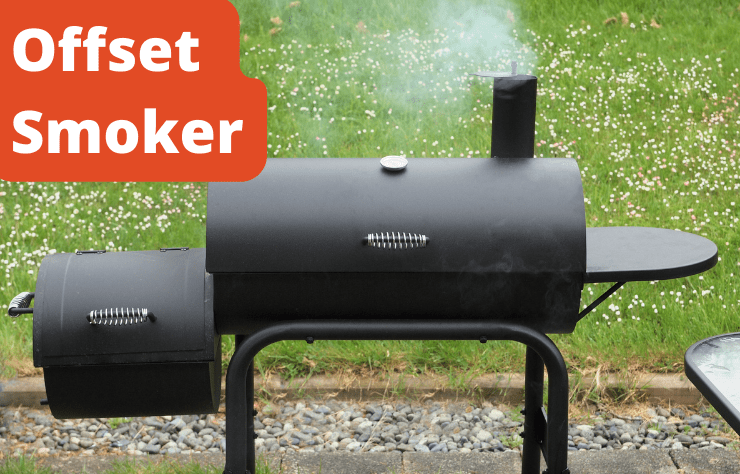We all know that one guy that takes barbequing to another level. For him it’s more than food, it’s a sport.
And why shouldn’t it be?
The amount of practice and experience it takes to get a decent smoked meal is incomprehensible.

Setting aside the time it takes to get the finely sorted out charcoal, freshly hand butchered meat, and sauce that is perfectly balanced to match the level of spiciness in the meat, there would still be one thing that makes the whole experience top-notch.
We won’t miss the factor that if someone new to barbequing tried this heavy-duty appliance, it won’t be as pleasing as the juicy ribs coming out of it. You’ll need dedication and practice.
But still, everyone deserves to experience that smoky goodness. So if you want to learn more about these types of smokers, read on to find out.
What’s an Offset Smoker?
An offset smoker or also known as a stick burner or horizontal smoker is the one that dominates any barbecue experience.

As the name suggests, it has a horizontal barrel with a side box for the fire that cooks meat slowly on low heat. Which gives the meat a significant barbecue flavor and juicy tenderness.
How Does an Offset Smoker Works?
Despite the big size, horizontal offset smokers are pretty straightforward to use. The offset firebox provides heat to the meat that you put in the barrel, that’s the easy part. Maintaining the level of heat is the challenging one.

The main barrel consists of two airports or vents that allow the flow of air through the smoker and the meat to cook evenly. This is also known as reverse flow technology and this is the part where you need to be more focused than any other.
Controlling the temperature, adjusting the chimney, and maintaining the airflow take practice and experience but with few tips and guidelines, your first barbecue session would go much easier.
Guide to Using an Offset Smoker
Season your offset smoker
So you’ve bought your first offset smoker and you’ve arranged all the things you need for a perfect barbecue session, your fuel, time, meat, spices, and other condiments.
However, if you’re using your offset smoker for the first time you have to season your smoker. Open up the manufacturer’s instruction panel and follow the company’s instructions to wear off any protective sealings and factory grease from your smoker so that the harsh factory chemicals don’t get in your food while you’re cooking it. Read more about the Top 10 Best Electric Smokers in our new article.
Fuel for the firebox
Charcoal and wood are both the best ways to smoke your food. On one hand, good quality charcoal has been proven to be best for giving your food that distinctive smoky barbecue flavor, on the other hand, using woods as a fuel source improves the taste of meat on its own.
So instead of using one, we would recommend you to use both as fuel.
Prepare the fire
Preparing the fire is surprisingly easy and can be done in three simple steps.
- Add your chosen fuel into the firebox.
- Clump it up in the form of a pyramid.
- Light up your fuel and wait for 30 minutes.
Depending on which brand of offset smoker you’re using, there might be a chimney starter. If you do have one, then instead of piling up your entire fuel in one firebox, put half of it in the chimney starter. Lit the fuel up and allow it to burn the fuel in the firebox itself.
When you notice that your fuel in the box has started burning nicely, even it out by spreading it in the fire chamber and you’re ready for the next step.
Adjust the heat
When the fire is built up in the fire chamber, it’s time to adjust it according to your needs. This is done by maintaining the airflow by adjusting the dampers.
By adjusting the dampers you can control the fire. If you completely open them, more air would get in the chamber and more fuel would burn, resulting in more fire.
Using the temperature gauge, maintain the temperature as required by the recipe you’re using and then close the dampers halfway so that the hot air used for cooking the meat doesn’t escape and the temperature is maintained so that your food can be cooked thoroughly.
If you’re struggling to maintain the temperature, then open up the dampers and regularly check the heat through the temperature gauge. The blue fire is also a signal for good and well-maintained heat.
Check smoke
Before putting the meat in the main chamber, make sure that you’re getting a good kind of smoke for your meal.
If there’s dark smoke coming out of the chimney it probably means two things: your fuel is still burning in its initial stage or there’s too little fuel in the firebox. If any of these two happens, give the fuel a bit more time to burn or add more fuel to the chamber respectively.
If you’ve gotten the hold on the right kind of smoke, now’s the time to maintain it. Dampers are used for both adjusting the heat and the smoke as well. Too much smoke means you should close the dampers and too little means you’ve to open them up.
This would probably take a while to get a hang of it but after a few tries, you’ll feel proud of yourself for getting those juicy smoked ribs done.
Ready to cook
Now when you’ve adjusted and maintained all aspects of the offset smoker, it is the right time to cook your meat.
Place the kind of meat you’re craving on the grill and rotate after every few minutes so that it doesn’t get burned on one side. No matter, if your smoke got reverse flow technology or has automatic vents installed in it, this step is unskippable.
It might also be a bit hectic as you would be closing the chamber so that the meat cooks evenly and you still would have to adjust the temperature and smoke but a little practice would do the work.
Take Away
Offset smokers might not be the first choice for beginners but this guide will help you to get through your first barbecue session on this conventional appliance.
Choosing the right kind of fuel, understanding the nuances of the smoker, maintaining the heat, airflow, and smoke, are the steps that take time and patience, however, the results are delicious enough to do it the second time.






